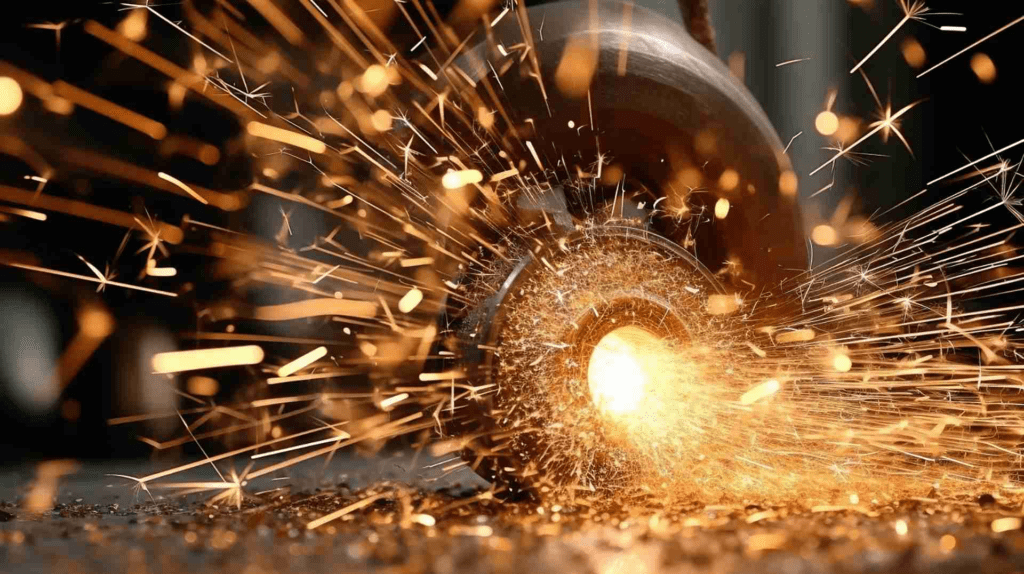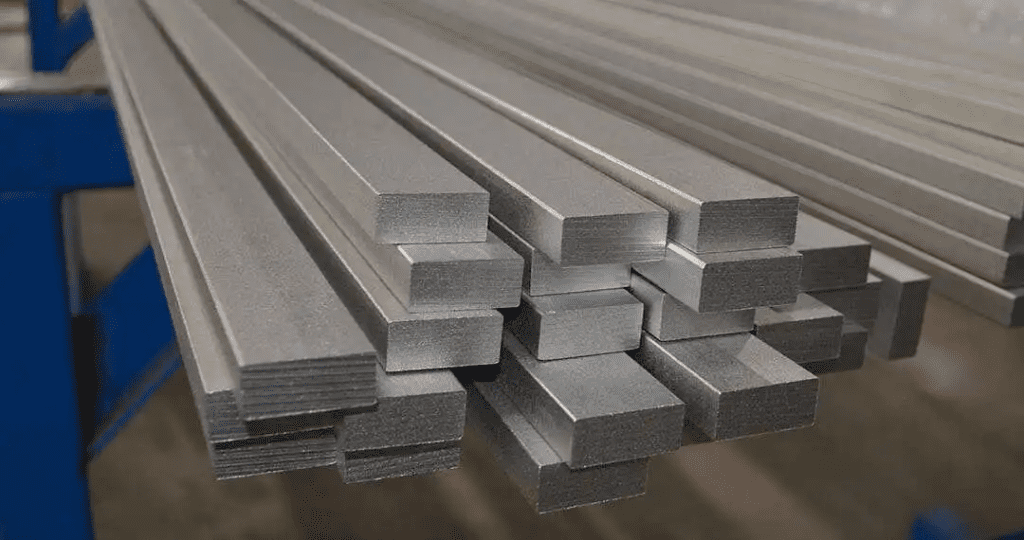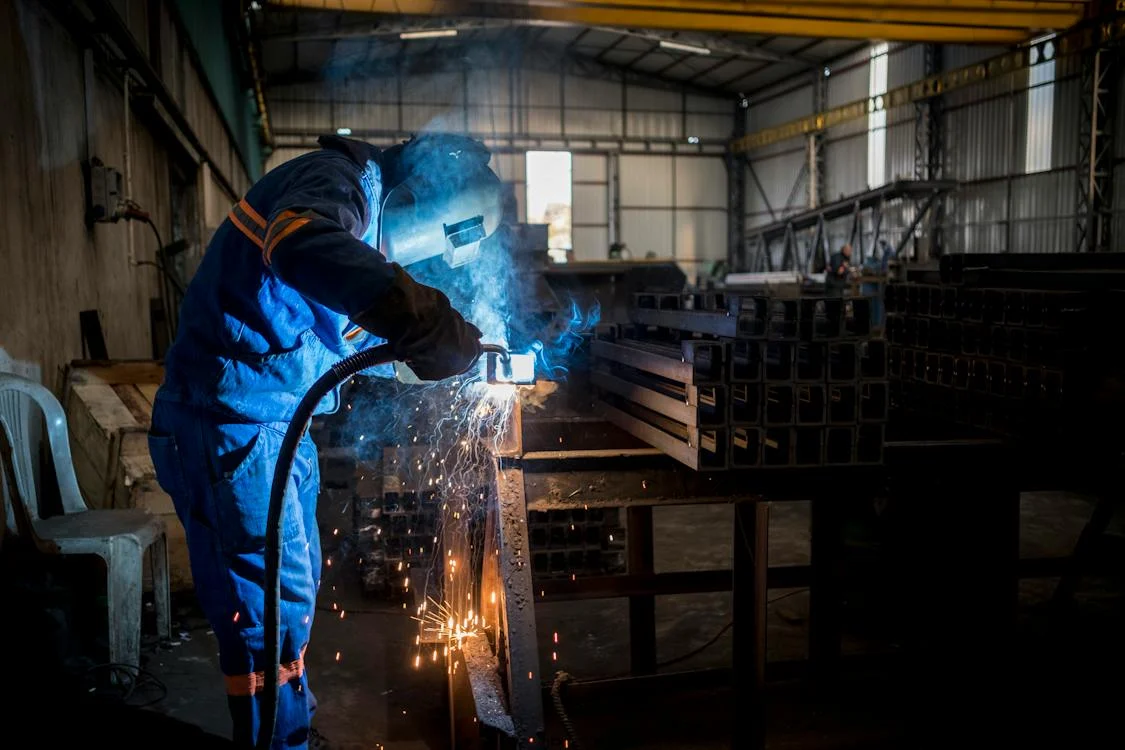The Metal Inert Gas (MIG) welding process is often used in heavy-duty fabrication projects, such as crafting metal gates. MIG welders use welding guns to spark electric arcs between the workpieces and the wire electrodes, generating intense heat that causes the joining parts to melt and ultimately cool to form a strong weld joint.
One of the notable advantages of MIG welding is its swiftness, which translates to reduced lead times and more cost-effective production. Furthermore, MIG welding is renowned for its user-friendliness, yielding welds that often require minimal or no post-weld cleaning and finishing efforts.
In this article, we’ll look at the following:
- What is MIG welding
- The components of MIG welding
- Applications of the MIG welding technique
- Advantages and downsides of MIG welding
What is MIG Welding
Metal Inert Gas welding, also known as Gas Metal Arc Welding (GMAW), is an arc welding process that has roots tracing back to the 20th Century. This technique caters to heavy-duty metal fabrications like pressure vessels, steel structures (e.g., metal gates), metallic pipelines, etc.
The MIG Welding Process
MIG welding typically involves continuously feeding a solid MIG wire electrode through a welder gun into a weld puddle. In this process, an electric arc forms between the electrode wire and the base metal, causing the base material to melt.
Consumable filler metal is then added to the molten metal, creating a solid weld. A shielding gas (argon) is simultaneously channeled through the welding gun that protects the weld metal from contamination. MIG welding mild steel is a common application of this process.
MIG welding machines cater to a broad spectrum of users, from home hobbyists, artists, farmers, and motorsports enthusiasts to DIY welders. They enable various fabrication and maintenance/repair welding tasks on materials varying from thin metal to robust thick metal. Mild steel MIG welding is particularly popular due to its versatility across different metal thicknesses.
When embarking on MIG welding, keep in mind the following tips:
- Prepare the base metal: The base metal should be clean and free of rust, grease, and other contaminants. This will help to ensure good weld quality.
- Appropriate filler wire and shielding gas: The filler wire should be compatible with the type of base metal you are welding. The shielding gas should be a mixture of argon and carbon dioxide (CO2) for mild steel or argon and helium for aluminum and stainless steel.
- Set the welding parameters: The voltage, amperage, and wire feed speed should be set according to the thickness of the base metal and the type of filler wire you are using. Consult the manufacturer’s instructions for your MIG welder for specific recommendations.
- Start the arc and weld the joint: Move the torch along the joint at a steady pace, keeping the contact tip to work distance (CTWD) consistent. The CTWD should be approximately 3/8″.
- Speed maintenance: Throughout the welding process, it’s vital to maintain a steady travel speed and consistent CTWD. This practice contributes to the creation of a uniform and reliable weld bead.
| Note: Allow the weld to cool completely before post-weld cleaning. Post-weld cleaning is necessary to remove any oxides or slag that may have formed on the weld bead. |
The Metal Inert Gas (MIG) Welding Components

MIG welding involves several critical components that work in unison to create solid and precise welds:
Wire Electrode
In MIG welding, the electrode not only carries the current but also serves as the filler material. The following are two fundamental types of wire electrodes, each suitable for specific projects and metal types:
- Hard wire: This type is preferred by most MIG users because of its affordability, ease of control, and versatility at various angles. Typical hard wires comprise a 3:1 ratio of argon and carbon dioxide for shielding gas.
- Flux-cored wire: The flux is incorporated into the wire, eliminating the need for separate shielding gas. This makes MIG welding more suitable for outdoor and windy conditions. However, flux-cored wires tend to produce slag during welding, which requires cleaning.
Welding Gun
The welding gun or welding torch (MIG torch) is the primary tool held by the MIG welder. It incorporates the electrode wire, shielding gas nozzle, and other vital components. MIG torches are categorized into the following groups:
- Gas-cooled welding torches: Typically sufficient for common welders engaged in minor projects as they often overheat when overused.
- Water-cooled welding torches: These can handle higher amperage and provide more power. They also offer smoother control over the contact tip of the nozzle. However, they come at a higher cost (around 20-30% more than gas-cooled torches) and require the welding machine to have a cooling system installed.
Shielding Gas
Shielding gas, usually composed of a blend of argon and carbon dioxide, plays a crucial role in safeguarding the weld pool from atmospheric contamination. Understanding how different shielding gases affect the resulting weld quality is essential. Shielding gases are classified into two main categories:
- Active gases: These gases influence the weld pool, spatter amount, and penetration depth. They include carbon dioxide (CO2) and oxygen (O2).
- Inert gases: Inert gas is the primary requirement, hence the name “metal inert gas” welding. These gases include argon (Ar) and helium (He).
When active gases are introduced into the shielding gas mixture, the process is referred to as “metal active gas” welding (MAG). However, in common practice, both approaches are often referred to as MIG welding due to the lack of a distinctive difference. Active gases can alter the welding characteristics, while inert gases do not interact with the welded metal.
|
Buy Certified High-Quality Metals for Industrial Solutions |
||
|
New Aluminum |
New Steel |
New Stainless Steel |
 |
 |
 |
| Reliable supply: Consistent, certified aluminum stock you can trust. High-quality material: Superior-grade aluminum for precision needs. Custom cuts: Accurate cuts down to thousandths of an inch. |
Durability and strength: Reliable for projects needing long-lasting, tough materials. Cost-effective: Quality steel that offers strength without breaking the bank. Custom cutting: Precise cuts tailored to exact needs with top-tier cutting tools. |
Sustainability: Highly eco-friendly as the most recyclable metal on earth. High durability: Resistant to corrosion and wear, ensuring long-lasting performance. Custom precision cuts: Tailored to your specifications with quick, accurate results. |
Distinguishing Between MIG and MAG Welding
Both MIG (Metal Inert Gas) and MAG (Metal Active Gas) welding belong to the GMAW (Gas Metal Arc Welding) family, and their core welding processes are virtually identical, save for the choice of shielding gas. Furthermore, you can execute MIG and MAG welding using the same welding machine; however, there is a distinct difference.
The MIG welding process opts for inert shielding gas such as argon or mixtures thereof. The inert gas remains stable during welding, emitting no particles into the weld bead. This results in a tough weld joint.
Contrary to MIG welders, MAG welders employ active shielding gases. Common active gases used in MAG welding include oxygen and carbon dioxide. MAG welding is the preferred choice for materials like steel, specifically stainless steel.
Applications of MIG Welding
MIG welding is favored for its versatility and is used in various industries and applications, including but not limited to:
- Farm repairs and outdoor use: The gasless MIG option, also known as FCAW (Flux-Cored Arc Welding), is ideal for outdoor and off-grid applications, making it a practical choice for farm repairs and other outdoor endeavors.
- General fabrication: MIG welding is often the method of choice for crafting frames, trailers, and similar structures due to its efficiency.
- Construction: In the construction industry, MIG welding’s speed and ability to weld relatively thick metal (up to 16mm at 350A) while requiring minimal cleanup, in contrast to stick welding, saves you time and money.
- Automotive repairs: MIG welding’s capability to weld sheet metal swiftly positions it as a preferred method for automotive repairs, outpacing TIG welding in speed.
- Pipe welding: In industries such as oil and gas and infrastructure projects, pipe welders frequently employ the MIG welding process to join pipes, guaranteeing the integrity of critical systems.
- Aerospace industry: MIG welding is employed in the aerospace sector to fabricate and repair aircraft components. Its ability to create strong and consistent welds is crucial for ensuring aircraft safety and structural integrity.
Marine industry: MIG welding plays a significant role in shipbuilding and repair. It’s used to weld various components of ships, including hulls, decks, and structural elements.
Pros and Cons of MIG Welding

MIG Welding has its advantages and disadvantages despite the advantages overriding the latter.
Advantages of MIG Welding
With its versatility and efficiency, MIG Welding presents you with several advantages, including the following:
- High welding speed and productivity: MIG welding is known for its fast and continuous operation, leading to increased productivity and shorter lead times.
- Versatility: It’s used to join various types and thicknesses of metals, making it suitable for a wide range of welding applications.
- All-position welding capability: MIG welding can be performed in horizontal, vertical, or flat positions, offering flexibility in welding tasks.
- Minimal cleanup: MIG welding produces less mess and requires minimal post-weld cleanup compared to other welding processes.
- Low waste: The continuously fed wire minimizes electrode waste, reducing material and cost wastage.
- Ease of learning: Thanks to its automated features, MIG welding is among the easiest welding techniques to learn.
- Excellent weld appearance: MIG welding typically results in a good-looking weld bead, enhancing the overall aesthetics of the weld.
- Support for various metal transfer modes: MIG welding supports different metal transfer modes, including pulsed MIG welding, providing versatility in welding techniques.
Disadvantages of MIG Welding
Even though MIG welding is widely favored and commonly used, it still has certain drawbacks. These drawbacks include the following:
- Higher initial equipment investment: MIG welding typically requires a greater initial investment in equipment compared to traditional stick welding, which can be a barrier for some welders, especially beginners.
- Limited metal thickness: MIG welding is most suitable for medium-thick or thin sheets of metals (typically between 0.6mm and 14mm), making it less ideal for extremely thick materials.
- Consumable costs: MIG welding requires frequent replacement of consumables such as tips and gas nozzles, leading to ongoing operating costs that may be higher compared to some other welding methods.
Frequently Asked Questions About MIG Welding
Due to its popularity, several questions might arise concerning MIG Welding. The following are a few set of FAQs;
What metals are welded using MIG welding?
MIG welding is flexible and can be used on various metals, including carbon steel, stainless steel, aluminum, copper, and non-ferrous metals and alloys. Clean materials and workspaces are important when welding stainless steel and other metals prone to contamination.
What’s the difference between MIG and TIG welding?
MIG welding uses a faster consumable wire electrode, making it suitable for thicker materials. TIG welding uses a non-consumable tungsten electrode and is preferred for precision when welding thin metals.
What is the maximum thickness MIG welding can handle?
The MIG welding machine can weld a wide range of thicknesses. It can handle materials as thin as 24-gauge sheet metal and can also weld metals up to 1/2-inch thick or more, depending on the equipment and settings.
 Angle
Angle Cast Plate
Cast Plate Diamond Plate
Diamond Plate Flat Bar
Flat Bar Plate
Plate Round Bar
Round Bar Square Bar
Square Bar Square Tubing
Square Tubing Round Tubing
Round Tubing Angle
Angle Channel
Channel Diamond Plate
Diamond Plate I Beam
I Beam Round Bar
Round Bar Sheet
Sheet Square tubing
Square tubing Round Tubing
Round Tubing Rectangular Tubing
Rectangular Tubing Plate
Plate Rectangular Bar
Rectangular Bar Rectangular Tubing
Rectangular Tubing Round Bar
Round Bar Sheet
Sheet Square Bar
Square Bar Square Tubing
Square Tubing
